Cross-posted from www.dancetheplay.co.uk
*Spoiler Alert* (Don’t read before watching!)
The Soho Poly was famous in the 1970s and 80s for lunchtime theatre, and its writers quickly had to adapt their style for short plays that people watched as they ate their lunch. Some playwrights, like Snoo Wilson and John Grillo, developed very visual, cartoon-like plays, designed to grab and hold an audience’s attention. But monologues were also popular, since tiny ‘fringe’ spaces like the Soho Poly encouraged intimacy between performers and audience. It’s not surprising that monologues have become popular again during lockdown. They’re the form least affected by social distancing and meet people’s need for closeness and companionship. But I also think it’s interesting that, just as writers, directors and actors were responding to the constraints of physical space in the 1970s, today they are responding to the limitations and opportunities of platforms like Youtube and Zoom. Dance was written before the lockdown, but maybe feels more suited to these new virtual spaces.
As for the play itself, Dance came about after I read an article about an Adele concert where a member of the audience was called out by the singer for filming. You can see the clip here.
Concerts have always been very important to me (I realise I’ve given that exact line to Richard in the play) and when I read this story I had a visceral reaction to it. I know what it means to see a band or singer you love, and how much you want to feel included in the experience. The thought of being humiliated in front of thousands of people by someone that you’ve invested so much in made me freeze. In a way, Dance is the story of that person at that gig.







